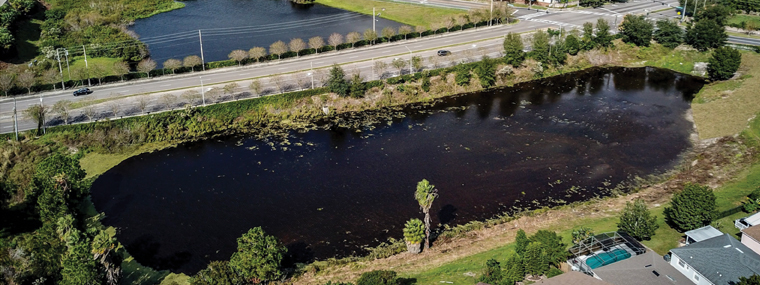
Ineffective Retention Pond Leads to Community Action
By Chad Bass / Published March 2021

As rapid development occurs throughout the state of Florida, it is not unusual for confusion to ensue between municipalities and community associations in regard to which entity has the responsibility for maintaining certain pieces of property.
This confusion over responsibility is frequently caused by roads cutting off parts of an association or simply a change of directors. Regardless, this does happen, and it can frequently result in dangerous conditions and eventually expensive repairs.
Recently, this was the case in suburban Orlando when a community association learned that it was responsible for maintaining what was once an effective and functioning retention pond that was built to collect rain run-off and prevent flooding.
The board wasn’t aware that this pond required maintenance until notified by city authorities. After years of neglect, this pond had become overgrown with cattails and other vegetation that rendered the retention pond ineffective.
 The pond was never intended to be for recreational use, such as fishing, boating, or hiking. There was little if any risk of pedestrian accidents since it was enclosed by a fence. Most of the danger was underground and out of sight to homeowners in the community.
The pond was never intended to be for recreational use, such as fishing, boating, or hiking. There was little if any risk of pedestrian accidents since it was enclosed by a fence. Most of the danger was underground and out of sight to homeowners in the community.
The important thing to realize is that in states with heavy rainfall, these ponds are created as a place for stormwater to flow as a way to keep roads and homes from flooding. The stormwater flows from streets and lawns through a sophisticated network of drains and pipes, which can accommodate millions of gallons that eventually end up in these retention ponds.
When this system is working properly, residents don’t notice, and many aren’t aware of the underground infrastructure which protects their homes, golf courses, roads, and open space. But when the pipes become obstructed, chaos results. Several canals and ponds can overflow, and water can flood homes. Standing water in roads becomes the norm.
 This community was in the early stages of facing these problems due to years of neglect. In short, this pond was not working as originally designed. After an assessment, we found many problems, including the following:
This community was in the early stages of facing these problems due to years of neglect. In short, this pond was not working as originally designed. After an assessment, we found many problems, including the following:
- Leaves, cattails, and other debris were reducing this pond’s carrying capacity by around 50 percent.
- The pond water was obscured by cattails that created floating islands, which could be mistaken for dry land.
- Wildlife (fish, birds, etc.) had abandoned the pond area in favor of better habitats.
Repairing and restoring this retention pond required a multi-faceted program involving these steps:
- Mechanically cutting the vegetation with the use of amphibious work boats.
- Removing root systems and muck with all-terrain excavators.
- Clearing drains and removing sediment.
- Hauling away approximately 100 truckloads of cattails, muck, and debris.
Within a matter of weeks, the pond was restored and the carrying capacity reached 100 percent. These strategies resulted in immediate drainage solutions. A community that once was threatened by flooding is now safe during heavy rains and hurricane seasons.
In addition, birds, fish, and other animals have been seen returning to a now- healthy natural habitat.
These situations are not uncommon. Boards should become educated on Florida’s complex drainage systems and how retention ponds should function.
The following are some signs that the drainage systems aren’t working properly:
- Water pools on the streets after heavy rainfall.
- Water levels are higher than usual for a longer period of time in lakes, ponds, or canals.
- Erosion develops along shorelines due to the pond’s elevated water level.
- Sediment piles are seen in front of pipes that enter the pond.
Other possible problems/solutions can include the following:
- Identification of non-native plants, which require removal in favor of native plants that provide important nutrients for fish and other wildlife.
- Consideration of dredging the lake/pond bottoms if algae are reoccurring and muck is present.
- Installation of pond aeration systems and aerating fountains to elevate levels of low oxygen.
- Installation of DredgeSOX® to increase the carry capacity of the pond and restore the shorelines all at once. These products provide cost-effective, long-lasting solutions for restoring shorelines.
As development continues throughout Florida, the importance of maintaining these flood control systems becomes even more important. Roads, large parking lots, homes, and other non-permeable surfaces create new conveyance paths for stormwater runoff. Once in place, these systems are extremely effective if monitored and maintained on a regular basis.
Chad Bass
Manager, Orlando Office, Lake and Wetland Management
Chad Bass is a manager of the Orlando office of Lake and Wetland Management. Founded in 1992, Lake and Wetland Management is a full-service environmental resource management company with 14 offices throughout Florida. For more information, visit www.lakeandwetland.com.





